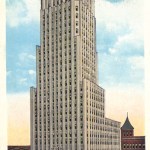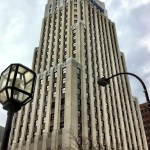- First Merit Tower Postcard, 1930s
- First Merit Tower, 2013
By James Caprio
During the 1920s and 1930s, Akron was one of the fastest growing cities in America. At the turn of the 20th century, Akron’s population was just under 70,000 people. By 1930, the population was over 255,000 people. Even in the midst of the Great Depression, Akron had become one of the major industrial hubs in the Midwest. Along with the rubber industry, Akron’s banks became very profitable. In 1929, the Central Savings and Trust Company, formerly the Central Depositors Bank, started a project to signify Akron’s booming population and industry. They created the Central Trust Tower, Akron’s first skyscraper. The skyscraper was designed by the Cleveland architectural firm Walker and Weeks. They designed the building Art-Deco style, a style that represents wealth, power, and security. It was also fashioned after the skyscrapers that dominated New York City’s skyline. When the tower was completed in 1931, it became a unique symbol of spirit and pride for both the blue-collar and white-collar citizens of Akron. The skyscraper stood at 308 feet tall, more than twice the height of any building in Akron at the time. The Central Trust bank moved into the entire first floor of the building and created innovations in banking with its new, much larger lobby. They eliminated the bank teller cages of old and created more personalized banking screens, giving their clients a better face to face experience. The building also housed an arcade of shops in the basement level and a restaurant at the street level. The skyscraper officially became known as the First National Bank Tower in 1931 and is now the First Merit Tower. To this day, it is still the greatest architectural achievement in the history of Akron, both structurally and symbolically.


